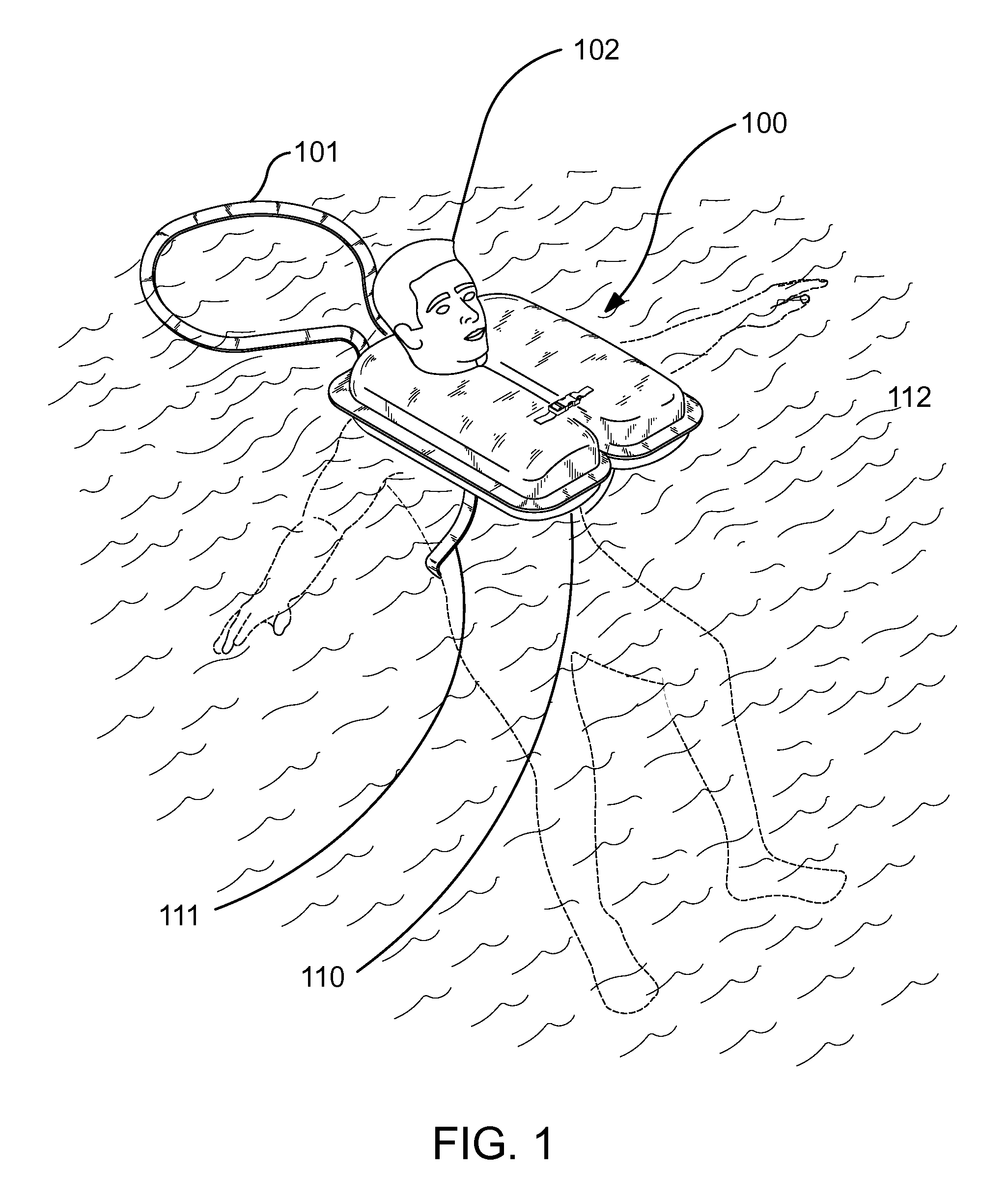Multi-functional, personal flotation device
a flotation device and multi-functional technology, applied in life-saving, waterborne vessels, life-buoys, etc., can solve the problems of difficult to find the location of mobs, complicated situations, clear life-threatening situations, etc., to facilitate easier and safer control of mobs
- Summary
- Abstract
- Description
- Claims
- Application Information
AI Technical Summary
Benefits of technology
Problems solved by technology
Method used
Image
Examples
example one
[0088]One such multi-functional PFD with integrated tether is shown in deployed position in FIG. 1. Multi-functional PFD 100 is formed with a tether of 1″ wide, high strength (900#) polypropylene flat webbing approximately 10′ long and with both ends of the tether 101 securely stitched to the back strap 113 of the automatically inflated PFD 110 forming a tether loop of approximately 36″ in diameter when deployed. This tether is folded onto the deflated buoyancy chamber prior to folding of the chamber and closure of the PFD 110 as shown in FIG. 16. Upon the MOB entering the water, the PFD is automatically activated, the buoyancy chambers inflate and unfold discharging the tether into the water. The polypropylene tether floats and provides a convenient and safe target for acquisition and recovery of the MOB by the rescuer.
example two
[0089]One such mast and tether system, shown in deployed position in FIG. 2, employs a collar 404 that is sealed by urethane adhesive to both the underside of the coated fabric casing 901 of buoyancy chamber 205 and the inside of the inflatable mast tube 501 as shown in cross section in FIG. 10. In this example, the mast tube 501 is formed with a lap seam 502. The collar 404 has an aperture 904 equal to the inside diameter of the collar bushing 903 providing a collar of “L” shaped cross section. The tether 101, of about 1.25 centimeters (0.5 inch) wide flat nylon webbing forms a tether loop 203 by stitching 172 and is securely attached along the length of the mast tube 501 by urethane adhesive. The top of the mast tube assembly is closed with a butt seam 701 to which the flat plastic cross member 204 of about 0.3 centimeter thick by about 2 centimeter wide by about 15 centimeters long is securely attached with adhesive. The tether loop 203 is securely attached to the cross member 20...
example three
[0091]Another mast tube assembly 201 is connected to the buoyancy chamber 205 without the use of a collar. In this example, the mast tube 501 is formed with a lap seam 502. Referring now to FIG. 11, several short longitudinal cuts 1101 are made in the bottom of the mast tube 501 and the resulting mast tabs 1102 are splayed out. The coated fabric of the buoyancy chamber 901 is similarly prepared as shown in perspective in FIG. 11 by formation of an aperture 405 by a series of radial cuts in the coated fabric of the buoyancy chamber 901 and splaying the resulting buoyancy tabs 1103 open and upwards. Assembly of the mast tube into the PFD is shown in cross section in FIG. 12. In this assembly the tube member 501 of mast tube assembly 201 is inserted through the buoyancy chamber aperture 405 formed in the coated fabric of the buoyancy chamber 901. The mast tabs 1102 are flattened or spread at the splayed end of the tube member 501 and are heat sealed to inner side of the coated fabric o...
PUM
 Login to View More
Login to View More Abstract
Description
Claims
Application Information
 Login to View More
Login to View More - R&D
- Intellectual Property
- Life Sciences
- Materials
- Tech Scout
- Unparalleled Data Quality
- Higher Quality Content
- 60% Fewer Hallucinations
Browse by: Latest US Patents, China's latest patents, Technical Efficacy Thesaurus, Application Domain, Technology Topic, Popular Technical Reports.
© 2025 PatSnap. All rights reserved.Legal|Privacy policy|Modern Slavery Act Transparency Statement|Sitemap|About US| Contact US: help@patsnap.com



